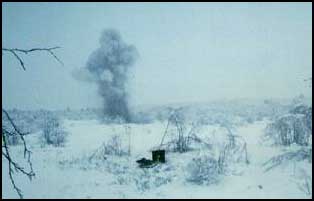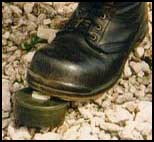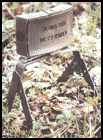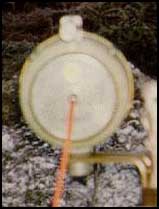
 |
| A m/52B anti-tank mine detonating |
| Mines are an important part of the Arctic Ranger arsenal, and are used mainly for ambushes and to mine incoming trails into your base. The mines used are of a wide variety, divided into anti-personnel, anti- vehicle and anti-tank mines. Anti-personnel mines are either dug into the ground or strapped on a tree, anti-vehicle mines are strapped up on trees, and anti-tank mines are dug into the ground or snow. |
| Mine m/10: (anti-personnel) |
 This is a small circular mine, roughly 8 cm
(3 inches) in diameter and 3 cm (1 inch) tall. Due to
it's appearance it is sometimes referred to as the
"hockey puck". It weighs around 200 grams, 120
of which is explosives (TNT). It is totally non-metallic
and therefore difficult to detect. Like many other
anti-personnel mines this mine is now banned. Despite
what one might think of mines, this was a very merciful
mine due to the fact that it only took off your foot,
leaving you with an intact knee joint so you can more
easily use a prosthetic leg (I would personally rather
step on one of these than have half my face blown away by
shrapnel). When it was allowed, it was used mainly to
boobytrap areas that where already mined with anti-tank
mines, in order to make the area more difficult for enemy
engineers to clear. This is a small circular mine, roughly 8 cm
(3 inches) in diameter and 3 cm (1 inch) tall. Due to
it's appearance it is sometimes referred to as the
"hockey puck". It weighs around 200 grams, 120
of which is explosives (TNT). It is totally non-metallic
and therefore difficult to detect. Like many other
anti-personnel mines this mine is now banned. Despite
what one might think of mines, this was a very merciful
mine due to the fact that it only took off your foot,
leaving you with an intact knee joint so you can more
easily use a prosthetic leg (I would personally rather
step on one of these than have half my face blown away by
shrapnel). When it was allowed, it was used mainly to
boobytrap areas that where already mined with anti-tank
mines, in order to make the area more difficult for enemy
engineers to clear. |
| Mine m/12: (anti-personnel) |
 This is a directional shrapnel
mine, basically the same as the American M1A1 Claymore
mine. It weighs 3 kg, 0.7 of which is explosives (RDX).
It is filled with 449 shotgun-sized steel balls that are
scattered into a 60 degree arc when ignited. It is
effective within an area of 50 m deep, 20 m wide and 2 m
high. On the front of the mine is the famous text
"THIS SIDE TOWARD THE ENEMY" (in Swedish, of
course). It is usually placed on a tree, but can also be
placed on a leg support (see picture). You can either
ignite the mine elctrically, or attach a percussion
ignitor, which you either pull by hand or set up as a
tripwire. Since all anti-personnel land mines are
officially banned you have to rename your equipment to
stay operational, so it is now called a "defensive
charge" instead of "anti-personnel mine"
(don't you just hate all this politically correct
bullshit?). It is mainly used as a perimeter defense or
to boobytrap incoming tracks into the base, but can also
be used in ambushes against enemy troops or unarmored
vehicles such as supply trucks. This is a directional shrapnel
mine, basically the same as the American M1A1 Claymore
mine. It weighs 3 kg, 0.7 of which is explosives (RDX).
It is filled with 449 shotgun-sized steel balls that are
scattered into a 60 degree arc when ignited. It is
effective within an area of 50 m deep, 20 m wide and 2 m
high. On the front of the mine is the famous text
"THIS SIDE TOWARD THE ENEMY" (in Swedish, of
course). It is usually placed on a tree, but can also be
placed on a leg support (see picture). You can either
ignite the mine elctrically, or attach a percussion
ignitor, which you either pull by hand or set up as a
tripwire. Since all anti-personnel land mines are
officially banned you have to rename your equipment to
stay operational, so it is now called a "defensive
charge" instead of "anti-personnel mine"
(don't you just hate all this politically correct
bullshit?). It is mainly used as a perimeter defense or
to boobytrap incoming tracks into the base, but can also
be used in ambushes against enemy troops or unarmored
vehicles such as supply trucks. |
| Mine
m/2: (alarm mine) |
This is a small tree mounted "mine" used only during training in peacetime. It is used the same way as the above mentioned m/12 anti-personnel mine, for perimeter defence and incoming tracks, and is triggered with a tripwire. It is basically a firecracker, giving off a loud noise, bright light and smoke when it is ignited. The advantage of this is that you don't turn to Swiss cheese when you trigger one during training missions. |
| Mine m/13R: (anti-vehicle) |
 This is a smaller version of the m/13
anti-vehicle mine (not used by Arctic Rangers), hence the
extra R for Reduced. It is basically a very large version
of an anti- This is a smaller version of the m/13
anti-vehicle mine (not used by Arctic Rangers), hence the
extra R for Reduced. It is basically a very large version
of an anti-personnel mine such as the m/12 or Claymore, and is sometimes nicknamed "Turk TV" because it looks like a small television. It weighs 10 kg, 5.5 of which is explosives (RDX). It contains 843 steel balls, each with a diameter of 9.5 millimeters. The enormous firepower is roughly equivalent that of an entire rifle company opening fire simultaneously, and it effectively kills all living things in an area 100 m deep, 70 m wide and 3 m tall. It destroys almost any vehicle at ranges up to 50 meters. On the front of the mine is the famous text "THIS SIDE TOWARD THE ENEMY" (again, in Swedish). It is generally placed on a tree, and is either triggered with a remote ignitor or with a ripcord. The main targets are enemy supply trucks and other smaller lightly armored or unarmored vehicles. Several of these can be connected with det cord (read more about det cord in the "Igniting devices" section) so you can ignite them simultaneously. |
| Mine
m/14: (anti-vehicle) |
 This is a
small cylinder-shaped mine weighing 2.6 kg, 1.5 of which
is explosives (RDX). It contains a
solid copper disk, which turns into a superheated 80mm
slug upon ignition. This slug exits the mine at a speed
of 2000 m/s and can penetrate up to 60mm of armor plate,
and is effective against targets up to 30 meters. It is
placed on a tree, and is equipped with a small detachable
sighting mechanism. It is either triggered with a remote
ignitor or with a ripcord. The main targets are enemy
supply trucks, engineer vehicles and armored vehicles
such as MT-LBs. This is a
small cylinder-shaped mine weighing 2.6 kg, 1.5 of which
is explosives (RDX). It contains a
solid copper disk, which turns into a superheated 80mm
slug upon ignition. This slug exits the mine at a speed
of 2000 m/s and can penetrate up to 60mm of armor plate,
and is effective against targets up to 30 meters. It is
placed on a tree, and is equipped with a small detachable
sighting mechanism. It is either triggered with a remote
ignitor or with a ripcord. The main targets are enemy
supply trucks, engineer vehicles and armored vehicles
such as MT-LBs. |
| Mine m/6: (anti-tank) |
A big landmine, weighing a total of 8 kg, 4 of which is explosives (RDX). It is equipped with magnetic detection, which means that it can ignite even if a tank runs straight over it (so the tracks pass on each side of the mine). It is also equipped with an anti-handling device, so it ignites when enemy sappers try to lift them by hand. This means that it will ignite even if the enemy tries to clear it with plough-fitted tanks, that normally clear a path by pushing mines to the sides. This type of mine is used mainly on roads, especially to mine the debris around a demolished road culvert. Any enemy engineer vehicles that attempt to fix the demolished road will first have to face the anti-tank mines. To make their job even more difficult, you can place non-metallic m/10 anti-personnel mines (see above) around the anti-tank mines. And if you want to be realy evil, you can put a sniper 500 m away and shoot at them when they try to clear the mines by hand...... |
| Mine m/52B: (anti-tank) |
A big and flat landmine, weighing a total of 10 kg, 8 of which is explosives (TNT). It is an old fashioned pressure-triggered mine, and has no magnetic detection. In the winter you attach a special tilt rod, which basically looks like a radio antenna. The tilt rod ignites the mine if it is bent out of alignment with the mine, which is usefull if you place the mine in deep snow, where the tank would normally run several inches above the mine without igniting it. This type of mine is used in the same way as the above mentioned m/6. Instead of using it as a pressure-ignited mine you can place plastic explosives in the fuse well and remote igniting them with det cord (read more about det cord in the "Igniting devices" section). At the top of this page is a picture of a m/52B mine detonating, remote ignited from a distance of 300 m. |
Next: Plastic explosives
Previous: Handgrenades
Back to Grenades, mines and explosives